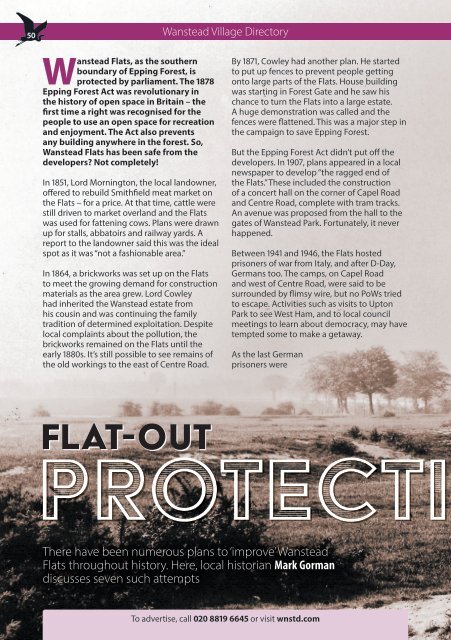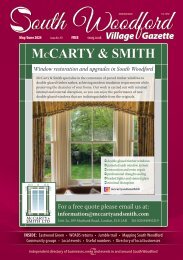February 2024
You also want an ePaper? Increase the reach of your titles
YUMPU automatically turns print PDFs into web optimized ePapers that Google loves.
Flat-out<br />
protectio<br />
50<br />
Wanstead Village Directory<br />
Wanstead Flats, as the southern<br />
boundary of Epping Forest, is<br />
protected by parliament. The 1878<br />
Epping Forest Act was revolutionary in<br />
the history of open space in Britain – the<br />
first time a right was recognised for the<br />
people to use an open space for recreation<br />
and enjoyment. The Act also prevents<br />
any building anywhere in the forest. So,<br />
Wanstead Flats has been safe from the<br />
developers? Not completely!<br />
In 1851, Lord Mornington, the local landowner,<br />
offered to rebuild Smithfield meat market on<br />
the Flats – for a price. At that time, cattle were<br />
still driven to market overland and the Flats<br />
was used for fattening cows. Plans were drawn<br />
up for stalls, abbatoirs and railway yards. A<br />
report to the landowner said this was the ideal<br />
spot as it was “not a fashionable area.”<br />
In 1864, a brickworks was set up on the Flats<br />
to meet the growing demand for construction<br />
materials as the area grew. Lord Cowley<br />
had inherited the Wanstead estate from<br />
his cousin and was continuing the family<br />
tradition of determined exploitation. Despite<br />
local complaints about the pollution, the<br />
brickworks remained on the Flats until the<br />
early 1880s. It’s still possible to see remains of<br />
the old workings to the east of Centre Road.<br />
By 1871, Cowley had another plan. He started<br />
to put up fences to prevent people getting<br />
onto large parts of the Flats. House building<br />
was starting in Forest Gate and he saw his<br />
chance to turn the Flats into a large estate.<br />
A huge demonstration was called and the<br />
fences were flattened. This was a major step in<br />
the campaign to save Epping Forest.<br />
But the Epping Forest Act didn’t put off the<br />
developers. In 1907, plans appeared in a local<br />
newspaper to develop “the ragged end of<br />
the Flats.” These included the construction<br />
of a concert hall on the corner of Capel Road<br />
and Centre Road, complete with tram tracks.<br />
An avenue was proposed from the hall to the<br />
gates of Wanstead Park. Fortunately, it never<br />
happened.<br />
Between 1941 and 1946, the Flats hosted<br />
prisoners of war from Italy, and after D-Day,<br />
Germans too. The camps, on Capel Road<br />
and west of Centre Road, were said to be<br />
surrounded by flimsy wire, but no PoWs tried<br />
to escape. Activities such as visits to Upton<br />
Park to see West Ham, and to local council<br />
meetings to learn about democracy, may have<br />
tempted some to make a getaway.<br />
As the last German<br />
prisoners were<br />
There have been numerous plans to ‘improve’ Wanstead<br />
Flats throughout history. Here, local historian Mark Gorman<br />
discusses seven such attempts<br />
To advertise, call 020 8819 6645 or visit wnstd.com
















